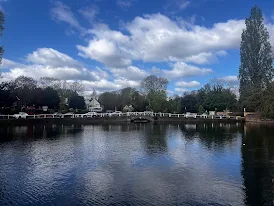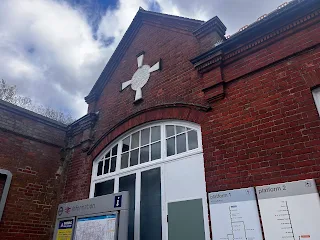Want a place that feels like a village but isn't? Then go to Carshalton. At its centre is a winding high street, bordered by ponds and a park that give a rather cozy feel to the place. Even some of the road signs call it a village. And I enjoyed walking around the place, though admittedly not spending enough time there. Perhaps there'll be more blogposts in the future on Carshalton.
It's also been around for a very long time. It was listed in the Domesday Book as Aultone, and no one knows where the "Carsh" part comes from. It's had a rich agricultural history involving sheep and walnuts, as well as once being home to lavender fields which urbanisation later removed. Daniel Defoe called it "the most agreeable spot on all this side of London" in 1757, though that was when it was mostly manors and not supermarkets. The River Wandle also passes through it, and the area also saw many snuff and paper mills alongside it [sourced from this website]. This classic rhyme references the region's love of beef:
"Sutton for mutton,
Carshalton for beeves,
Epsom for whores,
and Ewell for thieves."
The rhyme is courtesy of this website. Anyways, let's talk about the place itself.
Get off the bus by Carshalton High Street, and it's not too different from other town centres. There's the MP's office, there's the Sainsbury's Local, there's the pizza joint. Walk onwards, though, and it starts to narrow, offering a picturesque view of the ponds to your side.
These ponds happen to be one of the sources of the Wandle, the other being Waddon Ponds. They used to be one large pond, but were split in two - one for the public, the other private - so now you have to cross a busy road to get to either side. The eastern pond is in a much nicer place what with The Grove being nearby - a wonderful park which the Wandle weaves through, home to countless ducks and swans, as well as the occasional curious squirrel. It makes for a perfect place to take photos, and is full of interesting local history too. Take the Upper Mill, for example, once used to grind corn and now kept behind a fence, apparently sometimes open to the public. It also used to power Stone Court, a nearby mansion long demolished and owned by the Scawen family, then Lords of the Manor of Carshalton.
Here's the Old Rectory, which once housed the priests of Carshalton Church. Now, it stands by the entrance to a small backgarden, and it felt odd just wandering there. Just opposite it, meanwhile, stands the tallest London plane tree, at 123ft tall, whilst the Wandle flows peacefully beside it. As I continued to walk, I eventually spotted the Carshalton Water Tower, which is open at usually inconvenient times. Certainly impressive from outside the gate. As it turns out, it's less a water tower and more an ornate pump. Built by Sir John Fellowes over 300 years ago, it was made to transfer water to his house, and though eventually he lost possession of it, the structure still stands. It costs just £2 to enter, though at select times as I mentioned.
From here, I started heading north, thus leaving the village aesthetic firmly behind. At this point, I was closer to The Wrythe, which I didn't photograph as it's not all that interesting. I could mention the college that's here, or the various pubs, but instead I'll focus on two places.
Obviously I'll mention the local club - Carshalton Athletic, who have been around for 120 years. They now play in the Isthmian League with a nice stadium to boot. I'd have taken better photos if I ignored the steward's advice to not take pictures of children. Obviously I didn't, but even if I tried, the pitch was full of kids practising; at least the club is thriving. Though they lost on the day I came there.
Obviously I'll mention the railways, which partially explain why this "village" is far more urban. The first Carshalton station is now located in Wallington, and the current local one opened in 1868. Very quickly, the place began to grow, and though it pales in comparison to Sutton just down the road, it's meant that Carshalton is far less village-like than its residents may wish it to be.
Not that that means it's lost any of its character. The architecture is very endearing and lovely to look at - even the station with its cross looks quite traditional. And if you have a ticket, you can get to Central in no time. And it's on the Sutton loop, which I've blogged about before.
Few urban places manage to preserve their original feel like Carshalton has, and whilst it's definitely not the cheapest place to move into, it's definitely quite a unique part of South London. And I'll definitely come back there one day for another part and properly serve this blogpost some justice; I feel it could have been far more expansive. But that day, I was off to walk part of the Wandle Trail, so had no time left.










Comments
Post a Comment